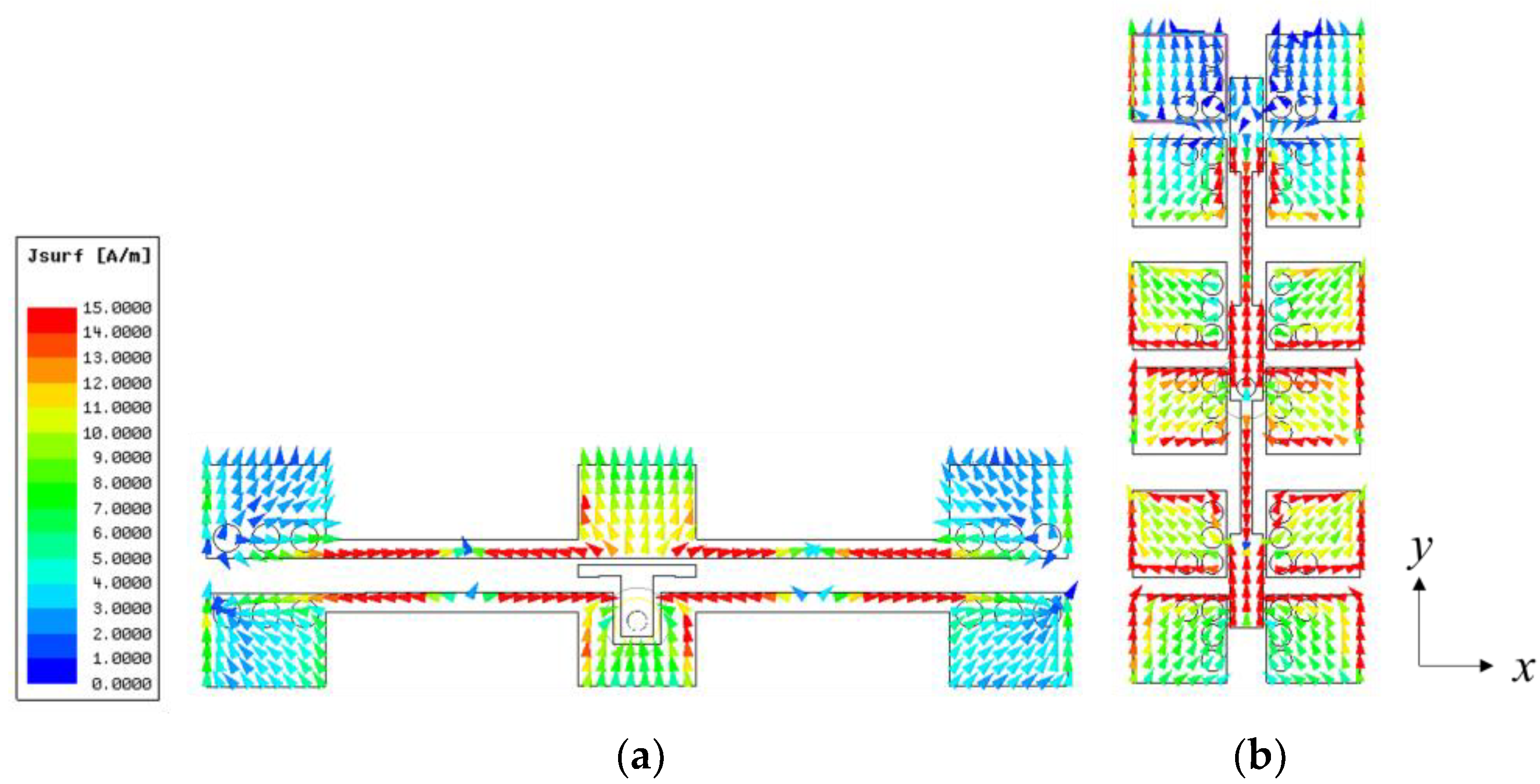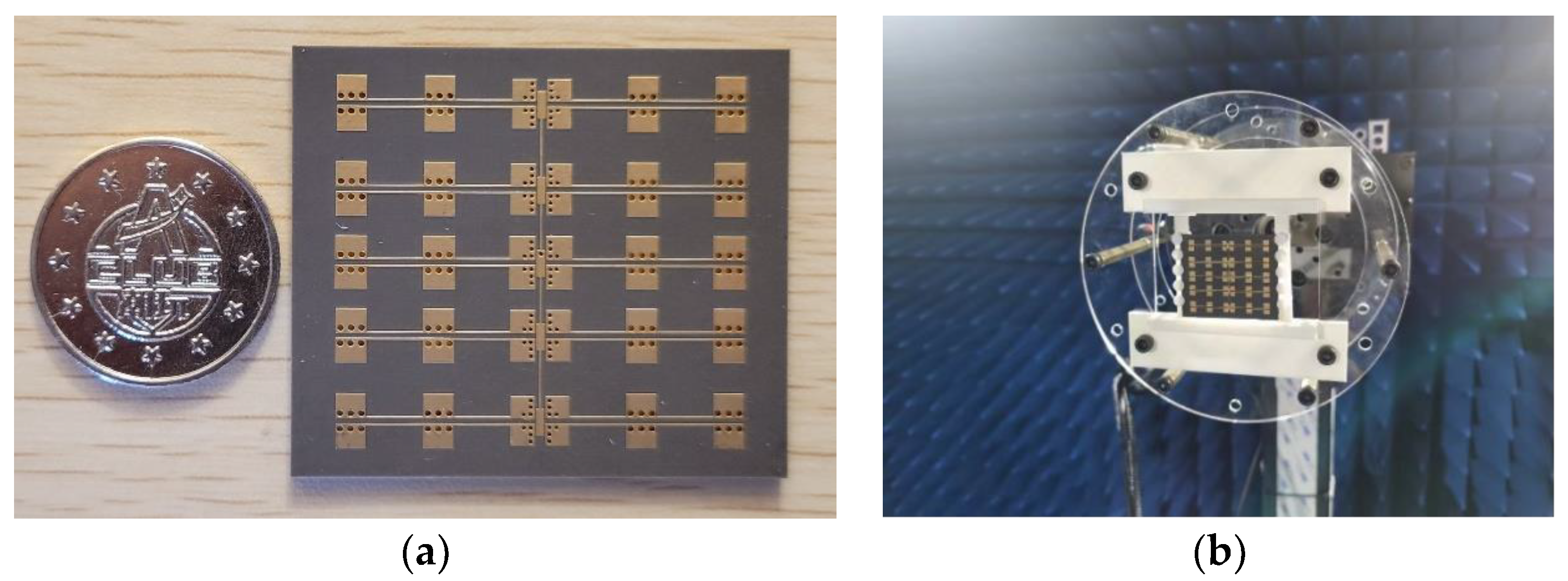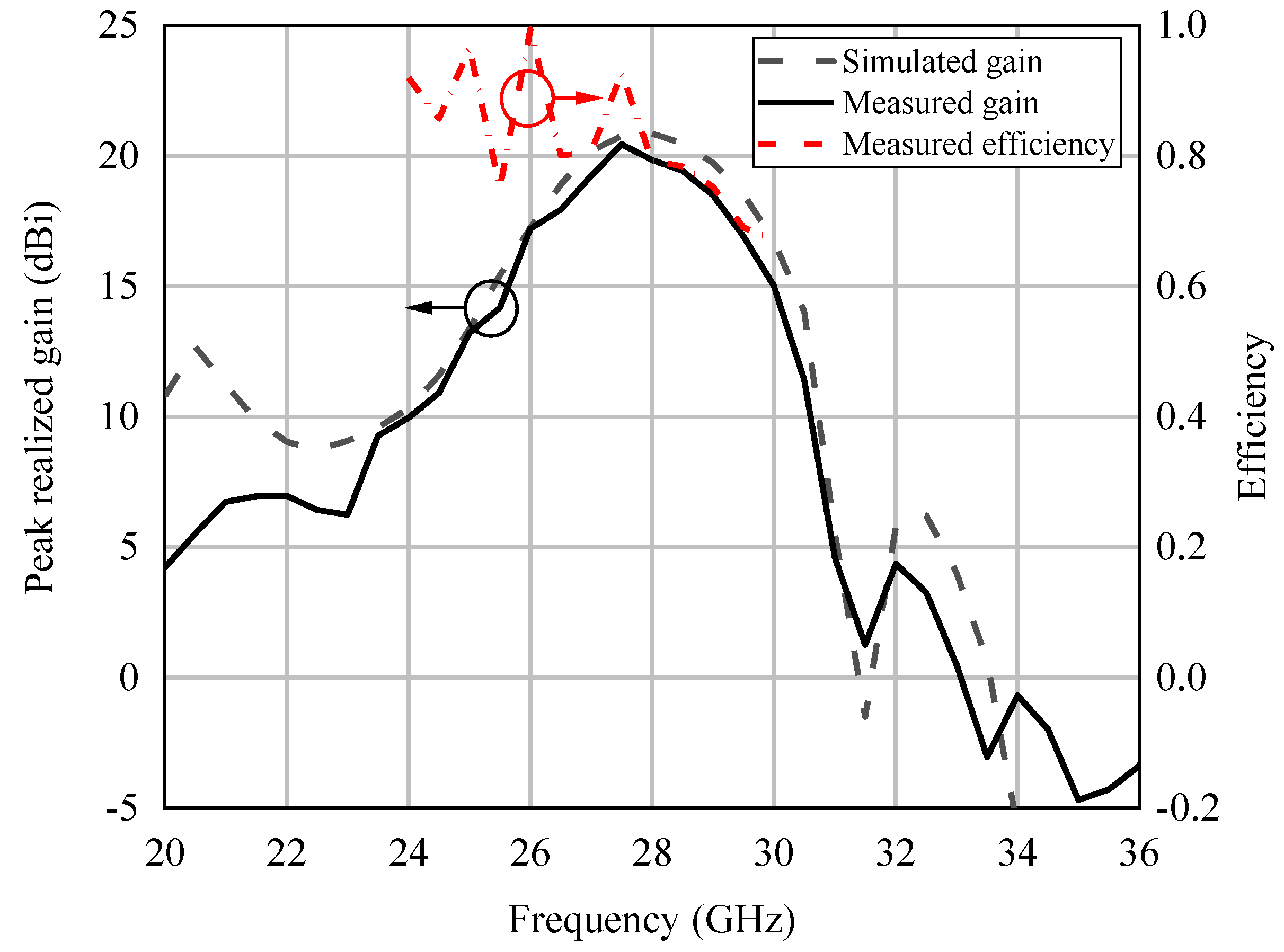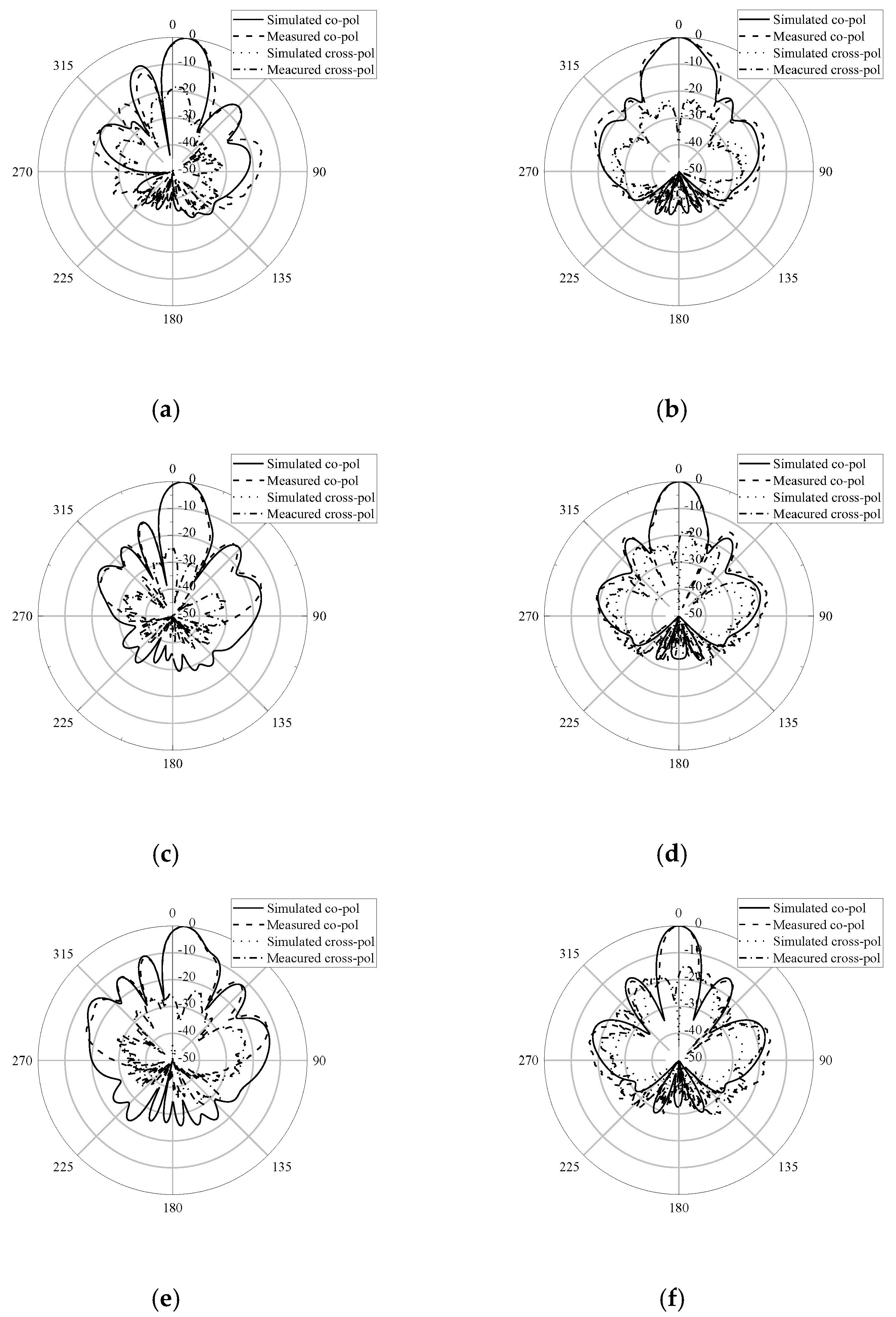Single-Layer Interconnected Magneto-Electric Dipole Antenna Array for 5G Communication Applications
Abstract
:1. Introduction
2. Design Procedure
2.1. Antenna Configuration
2.2. Interconnected ME Dipole Array Working Mechanism
2.3. Impedance-Matching Techniques of 1-D Interconnected ME Dipole Antenna Array
2.4. 2-D Interconnected ME Dipole Antenna Array
2.5. Sidelobe-Level Enhancement
3. Results and Discussion
4. Conclusions
Author Contributions
Funding
Institutional Review Board Statement
Informed Consent Statement
Data Availability Statement
Conflicts of Interest
References
- Han, W.; Yang, F.; Ouyang, J.; Yang, P. Low-cost wideband and high-gain slotted cavity antenna using high-order modes for mil-limeter-wave application. IEEE Trans. Antennas Propag. 2015, 63, 4624–4631. [Google Scholar] [CrossRef]
- Park, S.J.; Shin, D.H.; Park, S.O. Low side-lobe substrate-integrated-waveguide antenna array using broadband unequal feeding network for millimeter-wave handset device. IEEE Trans. Antennas Propag. 2016, 64, 923–932. [Google Scholar] [CrossRef]
- Dzagbletey, P.A.; Kim, K.S.; Byun, W.J.; Jung, Y.B. Stacked microstrip linear array with highly suppressed side-lobe levels and wide bandwidth. IET Microw. Antennas Propag. 2017, 11, 17–22. [Google Scholar] [CrossRef]
- Dzagbletey, P.A.; Jung, Y.B. Stacked microstrip linear array for millimeter-wave 5G baseband communication. IEEE Antennas Wirel. Propag. Lett. 2018, 17, 780–783. [Google Scholar] [CrossRef]
- Jin, H.; Che, W.; Chin, K.-S.; Yang, W.; Xue, Q. Millimeter-Wave TE20-Mode SIW Dual-Slot-Fed Patch Antenna Array With a Compact Differential Feeding Network. IEEE Trans. Antennas Propag. 2017, 66, 456–461. [Google Scholar] [CrossRef]
- Islam, S.; Zada, M.; Yoo, H. Highly Compact Integrated Sub-6 GHz and Millimeter-Wave Band Antenna Array for 5G Smartphone Communications. IEEE Trans. Antennas Propag. 2022, 70, 11629–11638. [Google Scholar] [CrossRef]
- Islam, S.; Zada, M.; Yoo, H. Low-Pass Filter Based Integrated 5G Smartphone Antenna for Sub-6-GHz and mm-Wave Bands. IEEE Trans. Antennas Propag. 2021, 69, 5424–5436. [Google Scholar] [CrossRef]
- Luk, K.M.; Wong, H. A new wideband unidirectional antenna element. Int. J. Microw. Opt. Technol. 2006, 1, 35–44. [Google Scholar]
- Hao, Z.-C.; Yuan, Q.; Li, B.-W.; Luo, G.Q. Wideband W-Band Substrate-Integrated Waveguide Magnetoelectric (ME) Dipole Array Antenna. IEEE Trans. Antennas Propag. 2018, 66, 3195–3200. [Google Scholar] [CrossRef]
- Xu, J.; Hong, W.; Jiang, Z.H.; Zhang, H. Millimeter-Wave Broadband Substrate Integrated Magneto-Electric Dipole Arrays With Corporate Low-Profile Microstrip Feeding Structures. IEEE Trans. Antennas Propag. 2020, 68, 7056–7067. [Google Scholar] [CrossRef]
- Ruan, X.; Ng, K.B.; Chan, C.H. A differentially fed transmission-line-excited magnetoelectric dipole antenna array for 5G applications. IEEE Trans. Antennas Propag. 2018, 66, 5224–5230. [Google Scholar] [CrossRef]
- Ruan, X.; Chan, C.H. A Circularly Polarized Differentially Fed Transmission-Line-Excited Magnetoelectric Dipole Antenna Array for 5G Applications. IEEE Trans. Antennas Propag. 2019, 67, 2002–2007. [Google Scholar] [CrossRef]
- Ruan, X.; Wang, K. A Transmission Line Transition to Extend the Transmission-Line-Excited Magnetoelectric Dipole Antenna Array. IEEE Antennas Wirel. Propag. Lett. 2022, 21, 863–867. [Google Scholar] [CrossRef]
- Zhu, Q.; Ng, K.B.; Chan, C.H.; Luk, K.M. Substrate-integrated-waveguide-fed array antenna covering 57–71 GHz band for 5G ap-plications. IEEE Trans. Antennas Propag. 2017, 65, 6298–6306. [Google Scholar] [CrossRef]
- Chen, W.; Yu, Z.; Zhai, J.; Zhou, J. Developing wideband dual-circularly polarized antenna with simple feeds using magneto-electric dipoles. IEEE Antennas Wirel. Propag. Lett. 2020, 19, 1037–1041. [Google Scholar] [CrossRef]
- Ge, L.; Luk, K.M. A Three-Element Linear Magneto-Electric Dipole Array With Beamwidth Reconfiguration. IEEE Antennas Wirel. Propag. Lett. 2014, 14, 28–31. [Google Scholar] [CrossRef]
- Ge, L.; Luk, K.-M. Linearly Polarized and Dual-Polarized Magneto-Electric Dipole Antennas With Reconfigurable Beamwidth in the H-plane. IEEE Trans. Antennas Propag. 2015, 64, 423–431. [Google Scholar] [CrossRef]
- Yang, S.J.; Pan, Y.M.; Zhang, Y.; Gao, Y.; Zhang, X.Y. Low-Profile Dual-Polarized Filtering Magneto-Electric Dipole Antenna for 5G Applications. IEEE Trans. Antennas Propag. 2019, 67, 6235–6243. [Google Scholar] [CrossRef]
- Zhang, Y.; Zhang, X.Y.; Liu, Q.H. Dual-polarized filtering magnetoelectric dipole antenna utilizing intrinsic highpass filter network and integrated lowpass filter network. IEEE Trans. Antennas Propag. 2021, 69, 8090–8099. [Google Scholar] [CrossRef]
- Li, Y.; Luk, K.M. 60-GHz dual-polarized two-dimensional switch-beam wideband antenna array of aperture-coupled magneto-electric dipoles. IEEE Trans. Antennas Propag. 2016, 64, 554–563. [Google Scholar] [CrossRef]
- Feng, B.; Chen, J.; Chung, K.L.; Wang, L.; Li, Y. Dual-Polarized Filtering Magneto-Electric Dipole Antenna Arrays With High Radiation-Suppression Index for 5G New Radio n258 Operations. IEEE Trans. Antennas Propag. 2021, 70, 3058–3063. [Google Scholar] [CrossRef]
- Ji, Z.; Sun, G.-H.; Wong, H. A wideband circularly polarized complementary antenna for millimeter-wave applications. IEEE Trans. Antennas Propag. 2022, 70, 2392–2400. [Google Scholar] [CrossRef]













| Parameters | Value (mm) | Parameters | Value (mm) |
|---|---|---|---|
| Fl | 2.7 | Fp | 1 |
| Fw | 0.8 | P1 | 2.4 |
| P2 | 2.6 | P3 | 2.45 |
| P4 | 3.1 | lw | 0.2 |
| S1 | 0.5 | S2 | 1.1 |
| l | 7.3 | l1 | 8.5 |
| l3 | 10.2 | lwy | 0.2 |
| l4 | 8.8 |
| Ref. | f0 (GHz) | Radiating Element | Amount of Substrates | Scale | Imp. BW (%) | Extension Ability | 3 dB Gain BW (%) | Peak Gain (dBi) | Overall Profile Height (mm) | Size (λ × λ) |
|---|---|---|---|---|---|---|---|---|---|---|
| [1] | 32.3 | slot | 1 | 4 × 4 | 26 | No | 14.1 | 13.8 | 1.58 | 1.72 × 1.72 |
| [2] | 28.45 | patch | 3 | 1 × 8 | 8 | Yes | / | 13.97 | 2.024 | 6.64 × 6.02 |
| [3] | 27.85 | patch | 2 | 1 × 7 | 7.54 | Yes | / | 14.71 | 1.07 | 8.92 × 1.88 |
| [4] | 27.7 | patch | 2 | 6 × 7 | 6.3 | Yes | 5.4 | 21.8 | 1.07 | 6.88 × 8.27 |
| [5] | 28 | patch | 3 | 4 × 4 | 8.5 | Yes | 8.5 | 19.1 | 1.5 | 3.92 × 3.55 |
| [12] | 64.4 | ME dipole | 3 | 4 × 4 | 26.7 | Yes | 26.4 | 21.5 | 2.5 | 3.09 × 3.09 |
| 63.35 | ME dipole | 3 | 8 × 8 | 22.9 | Yes | 23.6 | 26.7 | 2.6 | 6.08 × 6.08 | |
| [7] | 45.05 | ME dipole | 2 | 2 × 2 | 36.6 | Yes | 36.6 | 12.2 | 1.016 | 6 × 6 |
| [13] | 84.25 | ME dipole | 2 | 8 × 4 | 13.9 | Yes | 13.89 | 20.3 | 1.017 | / |
| [8] | 28.32 | ME dipole | 2 | 4 × 4 | 44.6 | Yes | 47.7 | 19.18 | 1.737 | 2.83 × 2.83 |
| 27.7 | ME dipole | 2 | 8 × 8 | 44 | Yes | 44 | 25 | 1.738 | 5.54 × 5.54 | |
| This work | 28 | ME dipole | 1 | 5 × 5 | 52 | Yes | 12.5 | 20.44 | 1.57 | 4.00 × 4.67 |
Disclaimer/Publisher’s Note: The statements, opinions and data contained in all publications are solely those of the individual author(s) and contributor(s) and not of MDPI and/or the editor(s). MDPI and/or the editor(s) disclaim responsibility for any injury to people or property resulting from any ideas, methods, instructions or products referred to in the content. |
© 2023 by the authors. Licensee MDPI, Basel, Switzerland. This article is an open access article distributed under the terms and conditions of the Creative Commons Attribution (CC BY) license (https://creativecommons.org/licenses/by/4.0/).
Share and Cite
Chen, Z.; Zhang, W.; Wang, K. Single-Layer Interconnected Magneto-Electric Dipole Antenna Array for 5G Communication Applications. Electronics 2023, 12, 922. https://doi.org/10.3390/electronics12040922
Chen Z, Zhang W, Wang K. Single-Layer Interconnected Magneto-Electric Dipole Antenna Array for 5G Communication Applications. Electronics. 2023; 12(4):922. https://doi.org/10.3390/electronics12040922
Chicago/Turabian StyleChen, Zihao, Wenxu Zhang, and Kaixu Wang. 2023. "Single-Layer Interconnected Magneto-Electric Dipole Antenna Array for 5G Communication Applications" Electronics 12, no. 4: 922. https://doi.org/10.3390/electronics12040922
APA StyleChen, Z., Zhang, W., & Wang, K. (2023). Single-Layer Interconnected Magneto-Electric Dipole Antenna Array for 5G Communication Applications. Electronics, 12(4), 922. https://doi.org/10.3390/electronics12040922





